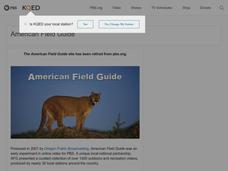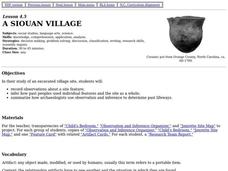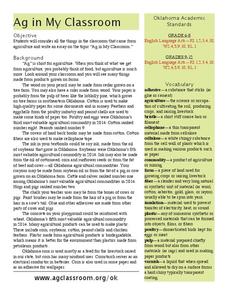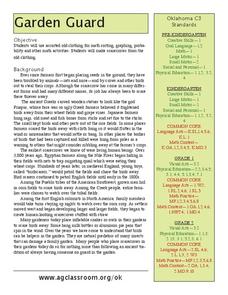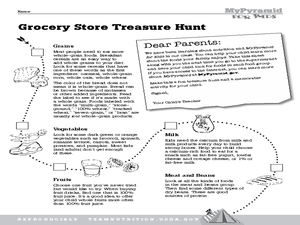Curated OER
Flowers and Plants
Students are assigned to bring five flowers. They explore flowers to distinguish different physical features of flowers. They compare and contrast different flowers to determine what features they have in common. Students develop an...
Curated OER
Plant Science Chapter #1
It may not stand as a cohesive presentation, but individually you may find a use for these slides. One slide describes how civilization began once man learned to plant and harvest food. Another explores the population growth over time....
Curated OER
A Siouan Village
Fourth graders examine the artifacts obtained from an excavated Siouan village site. They make inferences about the people who once lived there based on the artifacts and complete a Research Team Report.
Curated OER
"Blow, Wind, Blow" - Wind Power
In this renewable energy worksheet, students learn about wind power. They then answer the 2 questions on the worksheet. The answers are on the last page of the packet.
Curated OER
Living or Non-Living
Students examine living and non-living things. In this life science instructional activity, students are given a group of objects and discuss if they are living or non-living. Students identify and list characteristics of living things.
Curated OER
Planet Zorcon
Students relate the geography and economics of Utah. In this geography lesson plan, students log their use of resources both natural and synthetic. Students participate in an experiment to understand how the Earth will be in the future...
Curated OER
Endangered Species: Not Only Animals
Students research endangered animals and plants. In this biology lesson, students are read Will We Miss Them? Endangered Species by Alexandra Wright before they begin searching for information to complete an endangered species...
Curated OER
Agriculture Counts
Students discuss the kinds of things they count and how to use tally marks. In this social science lesson, students count animal crackers by using tally marks for each kind of animal. The tally marks are changed into numbers and one...
Curated OER
The Amazing Tomato
Students gain an understanding of where our food comes from. In this plant life lesson, students review what plants need for growth and how long it takes them to grow. Students research which plants it takes to make salsa. Students...
Curated OER
Contributions
Students taste rice, one of the Nations first people's contributions. In this contributions lesson plan, students discover what rice looks like, feels like and tastes like. Students make recipes using wild rice.
Curated OER
Ag in My Classroom
Students explore the definition of agriculture. For this Language Arts and Social Studies lesson, students read an article on products that are produced in agriculture, then they complete a vocabulary assignment and write an essay...
Curated OER
Be a Food Explorer
Students discover the origins of fruits and vegetables. In this nutrition lesson, students research how fruits and vegetables came to the United States via trade routes. Resources are provided.
Curated OER
Garden Guard
Students read about the history of farming with the use of scarecrows and then sort clothing, build scarecrows, write descriptions, and more. In this scarecrows lesson plan, students also play a game called Garden Tag.
Curated OER
Full Dolch Word List
Sight words are listed based on how frequently they are used. There are 250 words on the list. This would be a good, general resource for a teachers of grades 1 - 3. It is useful to know what words your class should know, and how well...
Curated OER
Rosa Parks Community Garden
Ninth graders investigate how we depend on plants as the original source of most food. They investigate the parts of plants, and which parts are edible. Students are explained that the garden is also a classroom and the same rules apply.
Curated OER
Investigate Factors Affecting Nitrates in Groundwater
Students participate in an experiment in which they investigate the factors affecting the levels of nitrates in groundwater. Using examples, they explain the nitrogen cycle and identify the sources of chemical nitrogen fertilizers. ...
Curated OER
Multiplying Whole Numbers
In this multiplication of whole numbers worksheet, students follow step by step directions to multiply two pairs of numbers without using a calculator.
Curated OER
Honey Bunches of Oats
Students explore a variety of crops that are used in our food products utalizing a box of the cereal, Honey "Bunches of Oates." Percentages of each of the three different kinds of flakes present are calculated.
Curated OER
PLANT PARTS WE EAT
Young scholars identify an assortment of vegetables and learn how to locate the parts humans use for food. Students identify the plant parts we eat. Young scholars color the pictures on their worksheets as provided. Students match the...
Curated OER
What is Rice?
Second graders investigate the agricultural process of rice farming by creating a rice stationary item. In this farming lesson, 2nd graders read about rice plants and the techniques used to harvest the edible plant. Students...
Curated OER
Watchable Wildlife Checklist
In this wildlife worksheet, learners will read over a list of 28 native animal species, their needs, and interesting characteristics. This list can be used as a checklist when out on a hike or in the school yard to identify common wildlife.
Curated OER
Eat Smart with MyPyramid for Kids
Students investigate food examples from the food groups to explore a healthy diet. In this healthy eating lesson, students study the food pyramid and complete related worksheets. Students also play pyramid go fish.
Curated OER
By The Pound
Students develop mathematical skills using measurement in the form of weight. They also perform calculations to find cost and strengthen estimation skills while comparing the actual price. The context for the lesson plan is in the...


